Methods for treating Kalanchoe from diseases and pests
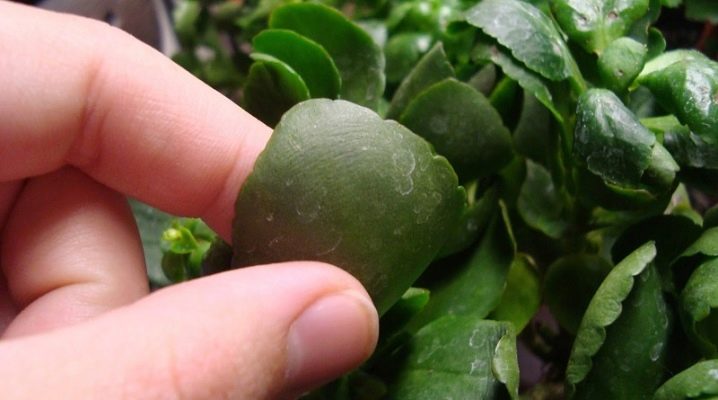
Kalanchoe is a calm flower that responds well to leaving. But he is also susceptible to diseases that can be easily "viewed". If you are a novice florist, then do not wait until the deterioration in the appearance of the Kalanchoe grows, carry out a diagnosis and start treatment. How exactly the flower is sick, how it is expressed, and how to help the plant, we will tell you point by point.
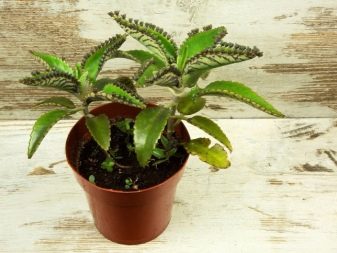
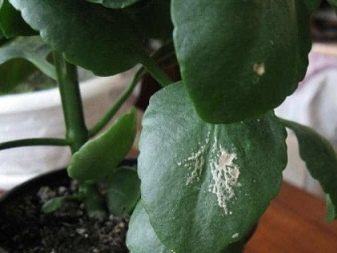
Symptoms and Causes
By the symptomatology, you can determine what kind of ailment struck the flower. The signs are usually bright, it is difficult to confuse the disease if the symptoms are severe. In search of the cause of diseases, be guided by the following list.
- Brown spots. This is late blight. This disease affects the flower with improperly organized ventilation, and excess moisture in the soil can also be the cause of the disease. At the beginning of the disease, brown spots appear on the leaves, gradually the Kalanchoe leaves are bent upward.
- White bloom. Such a sign most likely speaks of powdery mildew. This, alas, is a common diagnosis for Kalanchoe, a fungal disease most often occurs due to too humid air in the room. At first, it resembles a layer of dust, and if the florist does not inspect the Kalanchoe badly, then he may not attach importance to the bloom. But over time, the "dust" begins to become like flour. Because of this ailment, the plant sheds its leaves and withers.
- Gray rot. If the leaves curl up and rot, and the plant becomes soft, then this is gray rot. It leads to the formation of mold on the leaves. Such rot is precisely gray in color, which explains the name.
- Stem rot. When the Kalanchoe trunks dry and darken, it is stem rot. First, a small black dot appears on the trunk, then it grows to such a size that the entire trunk blackens. This happens with a sharp drop in temperature. If just such a phenomenon occurs in winter, the plant is threatened with death.
- Round small spots. Probably, we are talking about annular spotting. And this, unfortunately, is a verdict on the plant. It dries up and dies, therefore do not wait for an hour of complete wilting, get rid of the diseased flower as quickly as possible.
But not only diseases attack Kalanchoe. The leaves turn yellow and curl and from the attack of pests. If the tops of the plant are covered with black mold, and waxy discharge appears on the leaves and stem, this is a mealybug. If the flower has almost dried up in a short time, and its leaves are constantly curling, this is probably a scale insect. The leaves turn yellow from the tick, and if the Kalanchoe first turns yellow, and then throws off the leaves, it is probably necessary to fight with it.
To prevent the flower from withering, inspect it every day.
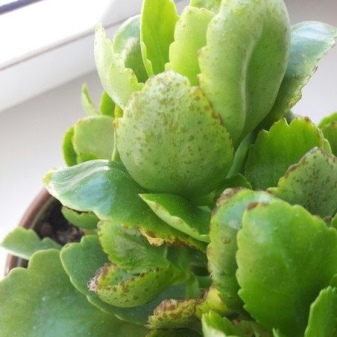

Common diseases
Now let's talk in more detail about the diseases that are most often diagnosed in this culture.
Late blight is the disease that leads to ugly brown spots on the flower. If you literally tortured a flower with increased watering or if it clearly lacks ventilation, it is most likely to get sick with late blight. When a flower begins to ache, dark spots dot almost every leaf. If nothing is done, the sheets will begin to bend up and fall off en masse. The plant needs to be rescued, for this buy the appropriate fungicide.
But besides the medicine, the flower also needs optimal care. To prevent diseases from pursuing the Kalanchoe in the future, start watering it correctly and, as necessary, apply fertilizer to the soil.
Another common diagnosis is powdery mildew. This is a common fungal disease that occurs due to excess moisture in the room. The disease provokes the shedding of foliage, followed by the death of the plant. Therefore, at the first suspicion of powdery mildew, begin to treat the flower. The disease is infectious, it will quickly move to other greens in the house, therefore the first measure is to isolate the diseased plant. The therapy consists in the use of fungicides.
There are several other Kalanchoe diseases that also need to be mentioned.
- Stem rot. You can trust the folk method, erase the stem plaque, and then disinfect this place with potassium permanganate (instead of potassium permanganate, some growers use ash). It is important to bring the temperature back to normal.
- Gray rot. She is also treated with fungicides. But even after their application, the plant needs resuscitation: it will require replacing the soil, ensuring the correct light regime.
When Kalanchoe disease is detected, examine other flowers in the room. It may be possible to find the source of the mass infection if it turns out that other flowers are also under threat.
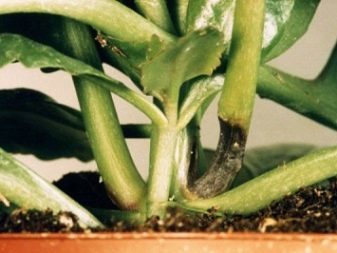
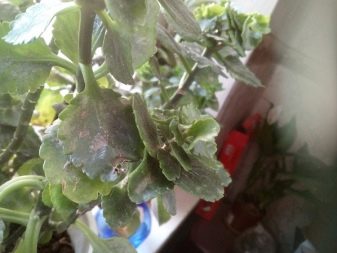
Pests
One of the main enemies of the Kalanchoe is aphid. She begins to express herself violently in the spring. And if the flower is not helped in time during the attack of the aphid, then it will not spare it and those plants that are located next to the Kalanchoe. Even a beginner will not find it difficult to identify aphids: black or green small insects will be visible on the stems of the flower, on its leaves.
Aphids are greedy for the sap of the plant, it poisons it, injecting its poison. The leaves and stems are gradually covered with a sticky mass. Aphids often appear due to very active nitrogenous fertilizing. And parasites get into the apartment either with a newly purchased flower or through cut buds. Therefore, if you bought flowers in a store or gave them to you, it makes sense to put them in a vase in another room (at least for a day). Aphids are also dangerous because they can carry about a hundred types of infections.
That's why it is recommended to burn the diseased parts of the flower, and treat the remaining intact with an insecticide. This should be done once a week for about a month. Potash soap is actively used from improvised means - 20 g of the product is diluted in a liter of water. The soil is wrapped in plastic wrap, then the flower is washed with a solution.
The scale insect is no less dangerous for the Kalanchoe. This insect is small, mobile, its body is equipped with a wax shield. Due to the attack of the scale insect, the culture cannot develop normally, it "skips" flowering, the leaves turn yellow and fall off. Both aphids and scale insects usually sit on the lower part of the leaf.
If you regularly spray Kalanchoe, then the scale insect is unlikely to stay on it, since it does not tolerate water procedures. But if you still find pests, then they will have to be collected.


How to save a flower?
Soap solution is the most popular folk remedy that is used in many cases. This kind of treatment can really help. Alcohol rubbing is also used: about three times a week, they rub the plant with a cotton swab dipped in vodka. You can replace alcohol with garlic infusion: five young cloves are ground, then diluted in a glass of water. Two hours of infusion in a dark place, filtering, and the infusion for spraying is ready. The scabbard can be removed from the sheet with a toothbrush.
In general, the scheme of what to do to treat a flower looks like this:
- he should arrange for proper care;
- if pests attack the flower, they must be eliminated in any suitable way, without wasting time;
- pinch;
- observe the optimal indicators of humidity, light mode and temperature;
- feed the plant.
These manipulations help the Kalanchoe to recover. On average, feeding is carried out once a month.Very often fertilizer for succulents is used for this purpose, but it is permissible to use complex additives (they give a good, lush flowering). Fertilizer should be applied as carefully as possible. If you overdo it with feeding, then the plant will not bear the abundant growth of the green mass, and it will not reach the flowers at all.
Pinching a flower helps not only to heal it, but also prevents it from drying out. You can pinch off with anything, the main thing is that the tool is processed, and the procedure is carried out carefully, without haste. If you can't pinch off carefully, sprinkle the wound with ash or charcoal.
It will not be possible to get rid of diseases without emergency measures, but even if you have cured Kalanchoe, special attention will have to be paid to its rehabilitation. It consists in maintaining an optimal complex of care.

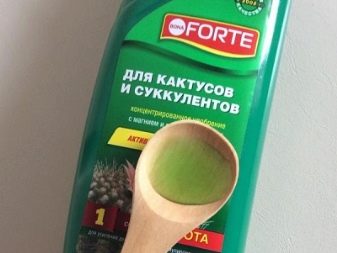
Proper plant care
You can grow a beautiful flower at home if you adhere to all the principles of proper care. And there are not so few of them.
- Watering. A plant is naturally capable of absorbing and retaining moisture well, therefore it is afraid of overflow, and not a lack of water. Moreover, a slight drought is even good for him. If the weather is hot, then, of course, you do not need to torment the plant, water it as needed. But in winter, try to protect the Kalanchoe from overflows. It is good if there is drainage in the flowerpot, it helps to keep the soil in excellent condition. The flower is watered not only from above, water is also poured into the pan.
- Lighting. Many "neighbors" of Kalanchoe do not tolerate direct UV rays, but this plant can withstand them well. But this is during the warm season. In winter, the plant goes into a kind of hibernation, therefore, most often it is transferred to a darkened window. In order for the plant to bloom, you will have to reduce the length of daylight hours, as strange as it sounds. Kalanchoe prefers to bloom in winter.
- Temperature. In warm weather, the culture will be comfortable if the temperature in the house is from 18 to 28 degrees. In winter, she tolerates the coolness - from plus 10 to 16 degrees. The plant takes root well on the insulated loggia and balcony.
- Transfer... The plant needs it for comfort. The root system of the Kalanchoe grows rather quickly, therefore, in the second half of spring, during the period of active growth of the flower, do not forget to transplant it. For this purpose, a new flowerpot is used, much larger than the previous container. But the composition of the soil remains the same. Take the flower out of the pot carefully so that the earthen lump is not damaged.
- Pruning. During flowering, pruning of Kalanchoe is carried out only in case of crop disease. Diseased areas should be carefully cut off at the junction with healthy ones. Flowering usually weakens the Kalanchoe, therefore do not forget to organize the flower for calm periods, for which you should cut off all flower stalks, put the flowerpot in a cool shaded place, do not water it for about a month and a half.
- Humidity. There is a lot of controversy about this: some claim that their flowers are absolutely indifferent to such an indicator as air humidity, while other growers convince that Kalanchoe cannot stand low humidity and dies. The truth is probably somewhere in between. Therefore, do not forget about regular light spraying, which will definitely not damage the flower. After the procedure, the leaves of the plant can be wiped with a sponge - this can be compared with SPA procedures, the flower will be grateful for such care, and will respond with health and beautiful flowering.
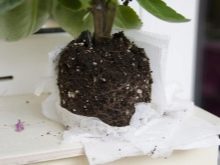
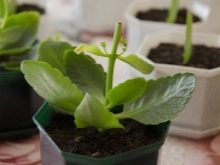
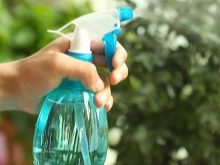
It is unlikely that proper care will help if you initially purchased not the healthiest flower. That's why even when buying, carefully examine the Kalanchoe: its leaves should be elastic and dense. It is good to take plants that have not yet blossomed flowers. If they have already formed so much that you can determine their color, but have not yet blossomed, it is easier for the plant to endure the move.
In autumn and spring, it is recommended to keep the plant near the western and eastern windows. It tolerates winter comfortably on the south side.If you bought a flower from a store where it lived in partial shade, it must be carefully accustomed to the sun. Otherwise, fatal burns are possible.
You can propagate a flower in different ways: seeds, cuttings (leaf / stem). The easiest way to reproduce is by children. They, separated from the mother plant, are planted in the soil. But reproduction by seeds is a much longer and more complex process, but still doable.
The plant is definitely worth such scrupulous care, because it is not for nothing that it is called "home ginseng". It is a great natural anti-inflammatory agent. Its juice is used in gynecology, dentistry, and in the treatment of flu and furunculosis.
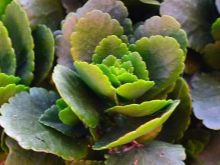
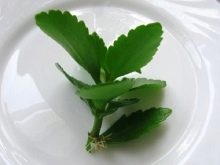
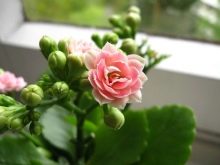
Do not self-medicate, but remember that a useful and very beautiful flower grows in your home, another name for which is the “tree of life”.
In the next video, you will find ways to treat Kalanchoe from diseases and pests.





















































The comment was sent successfully.